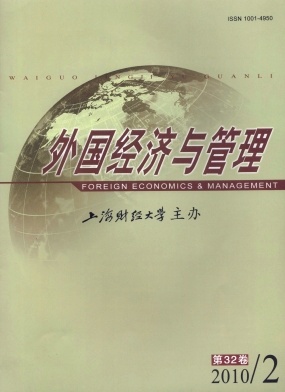负面营销事件中品牌资产的作用研究综述
外国经济与管理 2010 年 第 32 卷第 02 期, 页码:45 - 50
摘要
参考文献
摘要
品牌资产是企业非常重要的无形资产,能够在很多方面对企业产生积极影响。那么,在频繁爆发的负面营销事件中,品牌资产是否也会发挥积极的作用?本文针对这一问题,通过梳理现有研究成果,分析了品牌资产能够减弱和加剧负面营销事件的影响这两种不同的观点,并从多个视角展望了未来研究方向。
[1]Brady,Michael,Joseph Cronin,Gavin Fox,and Michelle L Roehm.Strategies to offset performance failures:The role of brand equi-ty[J].Journal of Retailing,2008,84(2):151-164.
[2]Lin,Zhiang,Xia Zhao,Kiran M Ismail,and Kathleen M Carley.Organizational design and restructuring in response to crises:Les-sons from computation modeling and real-world cases[J].Organization Science,2006,17(5):598-618.
[3]Keller,Lane Kevin.Conceptualizing,measuring,and managing customer-based brand equity[J].Journal of Marketing,1993,57(1):1-22.
[4]Ahluwalia,Rohini.Examination of psychological processes underlying resistance to persuasion[J].Journal of Consumer Research,2000,27(2):217-232.
[5]Rhee,Mooweon,and Pamela R Haunschild.The liability of good reputation:A study of product recalls in the US automobile indus-try[J].Organization Science,2006,17(1):101-117.
[6]Fiske,Susan T.Attention and weight in person perception:The impact of negative and extreme behavior[J].Journal of Personalityand Social Psychology,1980,38(6):889-906.
[7]Hogarth,Robin M,and HilleL J Einhorn.Order effects in belief updating:The belief adjustment model[J].Cognitive Psychology,1992,24(1):1-55.
[8]Weiner,B.Human motivation[M].New York:Holt,Rinehart and Winston,1980.
[9]Folkes,Valerie S.Consumer reaction to product failure:An attributional approach[J].Journal of Consumer Research,1984,10(4):398-409.
[10]Szymanski,D M,and D H Henard.Customer satisfaction:A meta-analysis of the empirical evidence[J].Academy of MarketingScience,2001,29(1):16-35.
[11]Burgoon,J K,and B A LePoire.Effect of communication expectancies,actual communication and expectancy disconfirmation on e-valuations of communicators and their communication behavior[J].Human Communication Research,1993,20(1):67-96.
[12]Cyert,L J,and M H DeGoot.Bayesian analysis and uncertainty in economic theory[M].Totowa,NJ:Rowman and Littlefield,1987.
[13]Sloot,L M,Peter C Verhoef,and Philip Franses.The impact of brand equity and the hedonic level of products on consumer stock-out reactions[J].Journal of Retailing,2005,81(1):15-34.
[14]Ahluwalia,Rohini,Robert E Burnkrant,and H Rao Unnava.Consumer response to negative publicity:The moderating role ofcommitment[J].Journal of Marketing Research,2000,37(5):203-214.
[15]Siomkos,George,and Gary Kurzbard.The hidden crisis in product-harm crisis management[J].European Journal of Marketing,1994,28(2):30-41.
[16]Raju,S,and Rao Unnava.The role of arousal in commitment:An explanation for the number of counterarguments[J].Journal ofConsumer Research,2006,33(9):173-178.
[17]Dean,Dwane Hal.Consumer reaction to negative publicity:Effect of corporate reputation,response,and responsibility for a crisisevent[J].Journal of Business Communication,2004,41(2):192-211.
[18]Mattila,Anna.The impact of service failures on customer loyalty[J].International Journal of Service Industry Management,2004,15(2):134-146.
[19]Roehm,Michelle,and Michael Brady.Consumer response to performance failures by high-equity brands[J].Journal of ConsumerResearch,2007,34(12):537-545.
[20]Kardes,F,Fennis,B,Zakary,H,and Bullington,B.The need for cognitive closure in the effectiveness of the disrupt-then-reframein influence technique[J].Journal of Consumer Research,2007,34(3):377-385.
[2]Lin,Zhiang,Xia Zhao,Kiran M Ismail,and Kathleen M Carley.Organizational design and restructuring in response to crises:Les-sons from computation modeling and real-world cases[J].Organization Science,2006,17(5):598-618.
[3]Keller,Lane Kevin.Conceptualizing,measuring,and managing customer-based brand equity[J].Journal of Marketing,1993,57(1):1-22.
[4]Ahluwalia,Rohini.Examination of psychological processes underlying resistance to persuasion[J].Journal of Consumer Research,2000,27(2):217-232.
[5]Rhee,Mooweon,and Pamela R Haunschild.The liability of good reputation:A study of product recalls in the US automobile indus-try[J].Organization Science,2006,17(1):101-117.
[6]Fiske,Susan T.Attention and weight in person perception:The impact of negative and extreme behavior[J].Journal of Personalityand Social Psychology,1980,38(6):889-906.
[7]Hogarth,Robin M,and HilleL J Einhorn.Order effects in belief updating:The belief adjustment model[J].Cognitive Psychology,1992,24(1):1-55.
[8]Weiner,B.Human motivation[M].New York:Holt,Rinehart and Winston,1980.
[9]Folkes,Valerie S.Consumer reaction to product failure:An attributional approach[J].Journal of Consumer Research,1984,10(4):398-409.
[10]Szymanski,D M,and D H Henard.Customer satisfaction:A meta-analysis of the empirical evidence[J].Academy of MarketingScience,2001,29(1):16-35.
[11]Burgoon,J K,and B A LePoire.Effect of communication expectancies,actual communication and expectancy disconfirmation on e-valuations of communicators and their communication behavior[J].Human Communication Research,1993,20(1):67-96.
[12]Cyert,L J,and M H DeGoot.Bayesian analysis and uncertainty in economic theory[M].Totowa,NJ:Rowman and Littlefield,1987.
[13]Sloot,L M,Peter C Verhoef,and Philip Franses.The impact of brand equity and the hedonic level of products on consumer stock-out reactions[J].Journal of Retailing,2005,81(1):15-34.
[14]Ahluwalia,Rohini,Robert E Burnkrant,and H Rao Unnava.Consumer response to negative publicity:The moderating role ofcommitment[J].Journal of Marketing Research,2000,37(5):203-214.
[15]Siomkos,George,and Gary Kurzbard.The hidden crisis in product-harm crisis management[J].European Journal of Marketing,1994,28(2):30-41.
[16]Raju,S,and Rao Unnava.The role of arousal in commitment:An explanation for the number of counterarguments[J].Journal ofConsumer Research,2006,33(9):173-178.
[17]Dean,Dwane Hal.Consumer reaction to negative publicity:Effect of corporate reputation,response,and responsibility for a crisisevent[J].Journal of Business Communication,2004,41(2):192-211.
[18]Mattila,Anna.The impact of service failures on customer loyalty[J].International Journal of Service Industry Management,2004,15(2):134-146.
[19]Roehm,Michelle,and Michael Brady.Consumer response to performance failures by high-equity brands[J].Journal of ConsumerResearch,2007,34(12):537-545.
[20]Kardes,F,Fennis,B,Zakary,H,and Bullington,B.The need for cognitive closure in the effectiveness of the disrupt-then-reframein influence technique[J].Journal of Consumer Research,2007,34(3):377-385.
引用本文
王晓玉. 负面营销事件中品牌资产的作用研究综述[J]. 外国经济与管理, 2010, 32(2): 45–50.
导出参考文献,格式为:
下一篇:标志性品牌研究述评





 6969
6969  333
333

